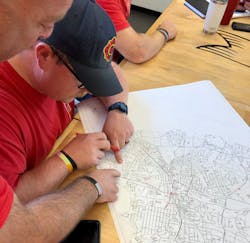Thinking Differently About Community Risk Reduction
Consider this: One afternoon, a business owner calls 9-1-1 to report an unconscious man on the outdoor pedestrian mall in front of her shop. The 9-1-1 center’s professional immediately triages the call, identifies the need for CPR instructions and provides directions to a public-access automated external defibrillator (AED) in a nearby pharmacy.
As a dispatcher alerts firefighters and paramedics, bystanders simultaneously begin CPR and rush to retrieve the AED.
The engine and ambulance respond through the streets quickly and directly to the pedestrian mall’s closest access point. The crews, carrying the right gear and possessing the proper training for the job, arrive to find that bystanders initiated early CPR and defibrillation. Immediate post-resuscitative care begins, and the man is transported rapidly to the most appropriate hospital. A battalion chief stays behind to collect contact information from the shopkeepers and bystanders who helped.
This story exemplifies a scenario that occurs every day. Fire departments strive to build highly responsive organizations to deploy effectively and efficiently to emergencies in their community. In many cases, all of the ducks align adequately, and a critical situation receives the best possible outcome. At some point, a chief receives an aggregated report that analyzes overall operational performance.
A broader view of CRR
The fire service is beginning to measure everything, from the time that members spend watching an online training video, to the time that it takes crews to dress out and roll an apparatus. Slow turnout times or skipped training might produce measurable negative effects on community outcomes. Thus, it must be accepted that many departments are entirely on board with the adage, “What is measured can be improved.” However, can the use of so many benchmarks and performance analytics genuinely be explained? Can an accurate picture of community opportunities and challenges be painted by visualizing these benchmarks across a timeline? Can the simplest of questions—“Why?”—be answered?
We can articulate “Why?” by thinking differently and adopting a broader view of community risk reduction (CRR). CRR isn’t the fire marshal’s office and public education. Instead, it’s a whole-organization approach to providing programs and services to best meet community needs. By embracing this broader view and applying the models of CRR, fire suppression, EMS, technical rescue, recruitment, incident command, functional fitness and other such elements all exhibit ties to improved community outcomes.
To transition toward thinking differently, you first must consider a simple timeline. In our work environments, many timelines start with incident response and include downstream times, such as “dispatch,” “en route” and “on scene.” In most cases, data stories end with marking a unit “in-service.” However, there are items that are on the timeline that contribute to the pre-incident environment, which include incident “discovery” and “notification.” If we go back in time far enough, we might find unmitigated “hazards and risks.” Additionally, after units return to service, there’s time in which the community participates in the process to achieve “recovery.”
We accept that prolonged response times have negative effects.
To drive this concept home a bit further, here’s an example: A 17-minute initial response to the aforementioned cardiac arrest scenario likely would affect the patient’s outcome. Additionally, a delay in incident discovery or a lapse between arrival and finding the actual emergency reduces a system’s effectiveness.
The number of scenarios that can influence outcomes is staggering.
To simplify the thought process and to gain a broader view using CRR, you should think about our world using a timeline and two primary benchmarks. The first benchmark is “incident,” and the implications are straightforward: If organizations and community partners institute strategies to mitigate the hazards and risks before an incident occurs, we can call it prevention. Unfortunately, loss of control, bad decisions and simple fate always will be excellent incident generators.
When an emergency occurs and generates an incident response, the next most important benchmark is “recovery.” The list of opportunities and influences for the department and community to successfully move across the timeline and to achieve recovery is nearly endless. Considering the aforementioned story, a quick turnout time, a knowledgeable driver/operator, good crew management and reliable training means that the time to recovery likely is at its most efficient. A delay in finishing sandwiches, a driver who is unfamiliar with the pedestrian mall’s access points, poor EMS training, missing cardiac monitor leads and no community follow-up pushes recovery far down the timeline.
Thinking differently and using these two benchmarks, the goal here is twofold: Either you prevent an incident’s occurrence, or you move “recovery” as close to “incident” as possible. In these terms, you can look at cardiac arrests, structure fires, pedestrian accidents, falls and even public-assistance calls in a much different light. You can see how training and credentials play a unique role, how strategic partners influence the timeline and how risk reduction in the community is broader than a fire marshal’s office.
Additionally, you can articulate how incident command, station design, firefighter fitness and even code enforcement can affect recovery. From the timeline perspective, the shrink or swell between the incremental benchmarks pushes or pulls recovery to or from the incident.
Myriad factors
Let’s break down the “incident” and “recovery” influences of the aforementioned story.
In the scenario, the department embraced a broad view of CRR. Working closely with the 9-1-1 center, the department influenced better triage for fire and EMS incidents. In addition, strategic community partners deployed hands-only CPR training during outdoor events on the downtown pedestrian mall. Department personnel created relationships with downtown merchants, they geolocated public access AEDs, and they tied the data into the computer-aided dispatch. Although the man experienced cardiac arrest, the area and time of the occurrence likely were the best in the city for a positive outcome.
Considering the factors that influenced the road to recovery, you can start with some of the elements that are outside of your control. For example, the time of day and day of the week played a crucial role in discovery and notification. Additionally, the social factors, including population density, human behavior and bystander assistance, pulled recovery closer to the incident.
From a department standpoint, it’s clear that the company officer influenced the driver to know the streets and access points and likely conducted pre-incident planning.
The 9-1-1 center likely worked to accurately triage the call as a cardiac arrest and relayed the information quickly.
The crews’ quick turnout time indicates that the department communicated the importance of closing the gap between incident and recovery in an acceptable way to match the culture.
The battalion chief’s work to collect information and follow-up shows the professional connection that’s with the community that’s served.
This same analysis can occur with any incident response and will expose opportunities and influences of CRR. Furthermore, you can visualize more of the elements that contribute to CRR along the timeline. A good risk-based code enforcement program might prevent incidents by mitigating hazards and risks, but it also can shrink the timeline that’s between discovery, notification and incident. Concurrently, tying post-incident fire investigations into firefighter training, public engagement and code enforcement provides effects across the spectrum.
From a nontraditional standpoint, how do inclusive hiring practices affect incident and recovery? Conducting public engagement with department members who have direct community ties can more effectively transmit the message, collect better information and achieve more community buy-in. Additionally, during an incident response, members of the community who are in crisis look for individuals who resemble them and who behave in a familiar manner. Hiring a workforce that matches the community brings recovery closer to the incident.
Two halves
The foundational success of CRR and moving recovery closer to the incident are rooted in risk assessments. Incremental risk assessments—starting small (to answer specific questions) and growing over time—provide valuable insight into the community’s needs. The risk assessment can guide resource deployment, training academy curriculums, social media, incident command strategies, functional fitness, human resource practice and policy.
The CRR model has organization-wide effects that change how we look at a program and service needs. Focusing on preventing incidents through a community-risk assessment is only half of the battle. Thinking differently, analyzing the response and identifying strategies to affect recovery comprise the other, equally important, half.
About the Author

Joe Powers
Joe Powers is a 28-year fire service veteran, holds a master's degree in public administration and is the managing director of Emergency Services Consulting International, which is the consulting firm of the International Association of Fire Chiefs (IAFC). He has worked closely with the Center for Public Safety Excellence, served as an IAFC board member for the Fire & Life Safety Section and is a past steering committee member for Vision 20/20. Powers, who believes that the industry's value extends beyond primary emergency response to building a more resilient community through risk assessment, partnerships and matching resources to need, frequently speaks at conferences on CRR strategic planning and fire service data.
